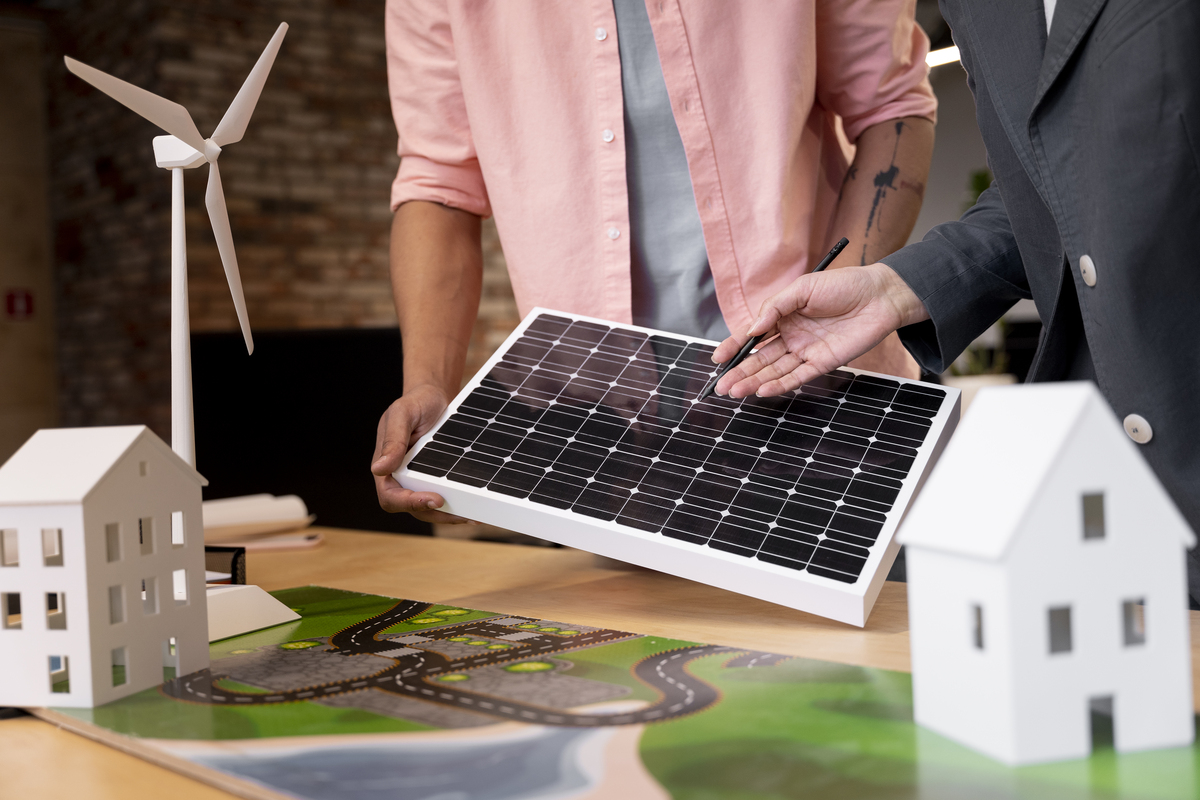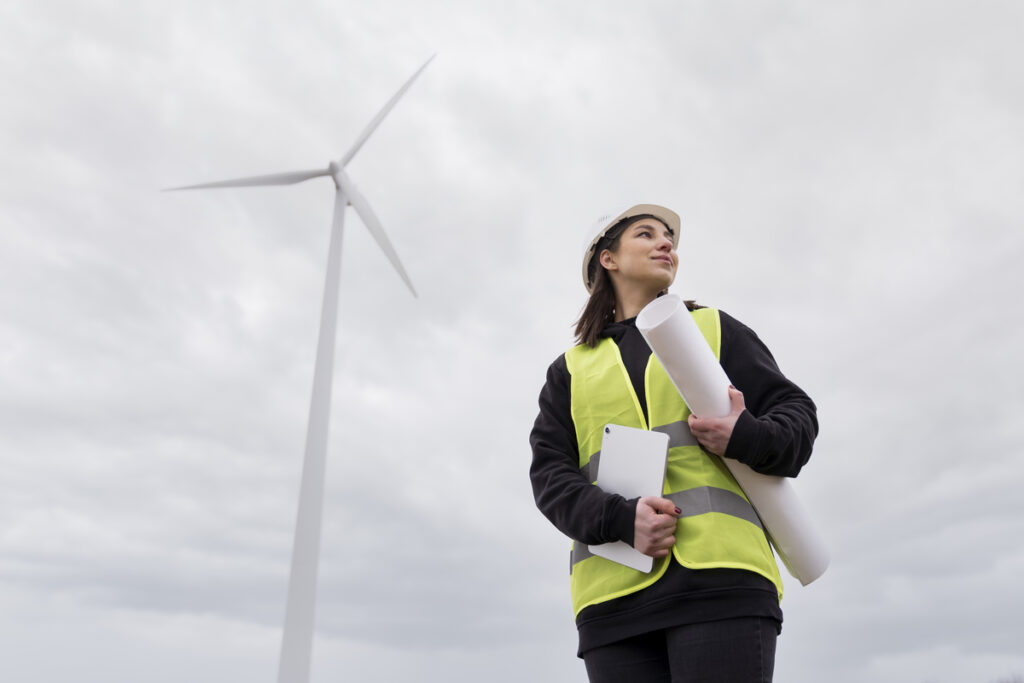Updated by Nazanin Ghodsian, 05/01/2025
In the pursuit of sustainable growth, the global construction sector is facing both possibilities and hitherto unseen challenges at this critical juncture. With 9.7 billion people predicted to live on Earth by 2050, there will be a greater need than ever for housing, infrastructure, and urban services, which will drive up construction costs. But there are negative social, economic, and environmental effects of this quick growth. The construction sector needs to completely incorporate sustainability principles into its practices and embrace the Sustainable Development Goals (SDGs) in order to overcome these issues.
The United Nations estimates that the building sector uses around 36% of the world’s energy and contributes about 39% of the carbon emissions associated with energy use worldwide. Furthermore, the building industry produces around 30% of the world’s garbage, which adds to biodiversity loss, habitat damage, and air and water pollution. The Sustainable Development Goals (SDGs) play a critical role in steering the construction sector towards more sustainable and responsible practices, particularly in light of the pressing global problems of resource depletion, climate change, and growing inequality.
Integrating SDGs in construction is crucial for addressing these worldwide issues and building a more reasonable, resilient, and eco-friendly buildings. This thorough investigation explores the SDGs’ beginnings as they relate to the building industry, their applicability to industry practices, and the guiding principles of sustainable construction technology. It will also emphasize the opportunities and difficulties that stakeholders have in putting these objectives into practice, as well as upcoming developments that will influence sustainable building practices.
To guarantee that the SDGs are successfully integrated into construction, key stakeholders—including legislators, architects, engineers, and construction companies—must work together. This study intends to motivate action and promote collaboration within the industry to realize a common vision for sustainable development by exhibiting best practices and creative solutions.
Table of Contents
Understanding SDGs
Understanding SDGs (Sustainable Development Goals) is crucial for addressing the most pressing global challenges and achieving a sustainable future for all. Introduced by the United Nations in 2015 as part of the 2030 Agenda for Sustainable Development, the SDGs in construction comprise 17 interconnected goals aimed at tackling poverty, inequality, climate change, environmental degradation, and fostering peace and prosperity worldwide.
- Origins of SDGs: The SDGs succeeded the Millennium Development Goals (MDGs) and were developed through an extensive consultative process involving governments, civil society organizations, academia, and the private sector. They reflect a shared commitment to transformative change and encompass economic, social, and environmental dimensions of development.
- The 17 Sustainable Development Goals: Each of the 17 SDGs in construction addresses specific areas of sustainable development, encompassing a wide range of issues critical to human well-being and planetary health. These goals include:
- No Poverty
- Zero Hunger
- Good Health and Well-being
- Quality Education
- Gender Equality
- Clean Water and Sanitation
- Affordable and Clean Energy
- Decent Work and Economic Growth
- Industry, Innovation, and Infrastructure
- Reduced Inequality
- Sustainable Cities and Communities
- Responsible Consumption and Production
- Climate Action
- Life Below Water
- Life on Land
- Peace, Justice, and Strong Institutions
- Partnerships for the Goals
- Interconnectedness of Goals: One of the key principles of the SDGs is their interconnectedness. Progress in one goal often depends on progress in others. For example, achieving gender equality (SDG 5) can positively impact poverty eradication (SDG 1) and economic growth (SDG 8). Similarly, addressing climate change (SDG 13) is crucial for protecting life on land and below water (SDGs 14 and 15).
- Targets and Indicators: Each SDG is accompanied by a set of targets (169 in total) and indicators (232 in total) that provide specific measurable objectives for tracking progress. These targets and indicators serve as a roadmap for governments, businesses, and civil society to monitor and evaluate their efforts toward achieving the goals.
- Global Adoption and Implementation: The SDGs in construction have been widely embraced by governments, businesses, NGOs, and communities around the world. Countries have committed to integrating the goals into their national development plans and policies, aligning their efforts with the overarching objective of leaving no one behind.
- Challenges and Opportunities: While significant progress has been made since the adoption of the SDGs, challenges remain, including insufficient funding, lack of data, and slow implementation in certain regions. However, the SDGs in construction also present immense opportunities for innovation, collaboration, and collective action to build a more equitable, resilient, and sustainable world.
In essence, understanding SDGs is not only about recognizing the interconnectedness of global challenges but also about embracing the shared responsibility to act decisively and inclusively toward achieving a sustainable future for present and future generations.
Suggested article to read: Decarbonizing Construction; A Sustainable Future Ahead (2025 Solution)

SDGs and Construction
The Sustainable Development Goals (SDGs) and the construction industry are closely intertwined, as construction activities have significant impacts on several aspects of sustainable development. Here’s how SDGs intersect with construction:
- Sustainable Infrastructure (SDG 9):
- Construction is a cornerstone of infrastructure development, including transportation, energy, water, and communication systems. Achieving SDG 9 involves promoting inclusive and sustainable industrialization, fostering innovation, and upgrading infrastructure. Sustainable construction practices can contribute to this goal by incorporating reusable materials in construction, energy-efficient designs, and resilient construction that withstands climate change impacts.
- Sustainable Cities and Communities (SDG 11):
- Construction plays a vital role in shaping urban landscapes and building sustainable communities. SDG 11 aims to make cities inclusive, safe, resilient, and sustainable. Sustainable construction practices can support this goal by promoting compact, efficient urban development, green building design, affordable housing, and accessible infrastructure for all residents.
- Climate Action (SDG 13):
- The construction industry is a significant contributor to greenhouse gas emissions, both directly through construction activities and indirectly through the production of building materials. SDG 13 calls for urgent action to combat climate change and its impacts. Sustainable construction practices, such as using renewable energy, reducing energy consumption, minimizing waste, and implementing green building standards like LEED (Leadership in Energy and Environmental Design) or BREEAM (Building Research Establishment Environmental Assessment Method), are essential for mitigating the carbon footprint in construction.
- Responsible Consumption and Production (SDG 12):
- Construction consumes vast amounts of natural resources and generates substantial waste throughout the building lifecycle. SDG 12 promotes sustainable consumption and production patterns to minimize resource depletion, waste generation, and environmental degradation. Adopting circular economy in construction, such as recycling and reusing materials, designing for deconstruction, and minimizing construction waste, can contribute to achieving this goal.
- Partnerships for the Goals (SDG 17):
- Collaboration among stakeholders is crucial for advancing sustainable development, including in the construction sector. SDG 17 emphasizes the importance of multi-stakeholder partnerships, knowledge-sharing, and capacity-building to achieve the SDGs. Building partnerships between governments, businesses, academia, NGOs, and communities can accelerate the adoption of sustainable construction practices, foster innovation, and mobilize resources for sustainable infrastructure development.
By aligning construction activities with the SDGs in construction, the industry can play a pivotal role in promoting economic growth, social equity, and environmental sustainability on a global scale. Embracing sustainable construction practices not only benefits the environment and society but also enhances the long-term viability and resilience of built assets for future generations.
Suggested article to read: Sustainable Construction Technology; Ultimate Guide in 2025
Integration of SDGs in Construction Practices
The integration of Sustainable Development Goals (SDGs) into construction practices is essential for promoting sustainable development, mitigating environmental impacts, and fostering social equity within the built environment. Here’s how SDGs can be integrated into construction practices:
- Adopting Sustainable Design Principles:
- Incorporate sustainable design principles from the early stages of project planning and development. Design buildings and infrastructure to minimize energy consumption, water usage, and waste generation while maximizing natural light, ventilation, and thermal comfort. Utilize green building rating systems like LEED or BREEAM to guide sustainable design decisions and ensure compliance with environmental performance standards.
- Using Renewable and Recycled Materials:
- Prioritize the use of renewable and recycled materials in construction to reduce the environmental footprint of building materials. Choose sustainably sourced timber, recycled steel, and low-carbon concrete to minimize embodied carbon emissions. Incorporate innovative materials such as bamboo, hempcrete, and recycled plastic to diversify material choices and promote circular economy principles.
- Implementing Energy-Efficient Technologies:
- Integrate energy-efficient technologies and renewable energy systems into building designs to reduce energy consumption and greenhouse gas emissions. Install high-performance insulation, energy-efficient HVAC in building (heating, ventilation, and air conditioning) systems, LED lighting, and smart building controls to optimize energy use and improve indoor environmental quality. Incorporate solar panels, wind turbines, and geothermal systems to generate clean, renewable energy onsite.
- Promoting Water Conservation Practices:
- Implement water-efficient fixtures, rainwater harvesting systems, and graywater recycling technologies to conserve water resources and reduce water consumption in buildings and landscapes. Design permeable surfaces, green roofs, and rain gardens to manage stormwater runoff and improve water infiltration into the soil. Educate building occupants on water-saving behaviors and promote responsible water use through signage, education campaigns, and water-saving incentives.
- Addressing Social Equity and Inclusion:
- Ensure that construction projects prioritize social equity, diversity, and inclusion in their planning, design, and implementation. Provide equitable access to housing, transportation, and public amenities for all community members, including vulnerable and marginalized populations. Engage with local stakeholders, community groups, and indigenous communities to incorporate their input and address their needs in project decision-making processes.
- Monitoring and Reporting Progress:
- Establish key performance indicators (KPIs) and metrics to track the progress and impact of sustainable construction practices on SDG targets. Conduct lifecycle assessments (LCAs) and environmental impact assessments (EIAs) to evaluate the environmental, social, and economic performance of construction projects. Regularly monitor and report on sustainability performance to stakeholders, investors, and regulatory authorities to demonstrate compliance with SDGs and sustainability commitments.
By integrating SDGs in construction, stakeholders can contribute to advancing sustainable development goals, reducing environmental impacts, and promoting social equity within the built environment. Embracing sustainable construction practices not only benefits the environment and society but also enhances the long-term resilience and viability of built assets for future generations.
Suggested article to read: Top 24 Sustainable Construction Technologies in 2025

Challenges and Opportunities
The integration of Sustainable Development Goals (SDGs) into construction practices presents both challenges and opportunities for the industry. Here’s a closer look at these aspects:
Challenges:
- Cost Considerations: Implementing sustainable construction practices often involves higher upfront costs due to investments in energy-efficient technologies, green materials, and sustainable design features. This can pose a challenge for developers and clients who prioritize short-term financial returns over long-term sustainability benefits.
- Lack of Awareness and Education: Many stakeholders in the construction industry, including architects, engineers, contractors, and clients, may have limited knowledge and awareness of sustainable construction practices and their potential benefits. Overcoming this knowledge gap requires comprehensive education and training programs to build capacity and foster a culture of sustainability within the industry.
- Regulatory Barriers: Inadequate or inconsistent regulatory frameworks may hinder the adoption of sustainable construction practices. Existing building codes and regulations may not adequately address sustainability considerations or may even discourage innovation in green building design and construction. Aligning regulatory frameworks with sustainable development goals requires collaboration between policymakers, industry stakeholders, and sustainability experts.
- Supply Chain Constraints: The availability of sustainable building materials and technologies may be limited, particularly in regions where green building markets are still emerging. Supply chain constraints, including sourcing, transportation, and logistics challenges, can affect the scalability and affordability of sustainable construction solutions.
- Resistance to Change: Resistance to change within the construction industry, including entrenched practices, outdated norms, and risk-averse attitudes, can impede the adoption of sustainable construction practices. Overcoming resistance to change requires strong leadership, stakeholder engagement, and evidence-based advocacy for the benefits of sustainability.
Opportunities:
- Innovation and Technological Advances: The pursuit of sustainable development goals in construction drives innovation and technological advances in green building materials, energy-efficient systems, and smart technologies. Investing in research and development (R&D) and fostering collaboration between academia, industry, and government can spur innovation and accelerate the adoption of sustainable construction practices.
- Market Demand for Sustainability: Growing awareness of environmental issues and increasing consumer demand for sustainable products and services create market opportunities for green building developers, contractors, and suppliers. Sustainable construction practices can differentiate projects in the marketplace, attract environmentally conscious clients, and enhance the reputation and brand value of companies committed to sustainability.
- Long-Term Cost Savings: While sustainable construction practices may entail higher upfront costs, they often result in long-term cost savings through reduced energy consumption, lower operating expenses, and enhanced asset value. Life-cycle cost analysis (LCCA) and return on investment (ROI) assessments demonstrate the economic benefits of sustainability and incentivize investment in green building projects.
- Regulatory Incentives and Certifications: Governments and regulatory authorities increasingly offer incentives, subsidies, and tax breaks to promote sustainable construction and achieve environmental targets. Green building certifications such as LEED, BREEAM, and Green Star provide third-party validation of sustainable building practices and facilitate market recognition and access to green financing options.
- Social and Environmental Benefits: Sustainable construction practices deliver tangible social and environmental benefits, including improved public health, enhanced occupant comfort and well-being, biodiversity conservation, and climate resilience. Embracing sustainability creates positive social impacts, fosters community engagement, and contributes to the achievement of broader sustainable development goals.
By addressing these challenges and seizing opportunities, the construction industry can play a pivotal role in advancing sustainable development goals, reducing environmental impacts, and creating a more resilient and equitable built environment for current and future generations.
Suggested article to read: Sustainable Construction; Comprehensive Guide 2025
Government Policies and Regulations
Government policies and regulations play a critical role in shaping the trajectory of sustainable development within the construction industry. Here’s how government actions can influence sustainable construction practices:
- Building Codes and Standards:
- Governments establish building codes and standards that regulate the design, construction, and operation of buildings and infrastructure. These codes often include requirements related to energy efficiency, water conservation, indoor air quality, and accessibility. Updating building codes to incorporate sustainability criteria encourages the adoption of green building practices and the use of environmentally friendly materials and technologies.
- Green Building Certification and Rating Systems:
- Governments may endorse or require compliance with green building certification and rating systems, such as LEED (Leadership in Energy and Environmental Design), BREEAM (Building Research Establishment Environmental Assessment Method), and Green Star. These voluntary certification programs provide benchmarks for sustainable building performance and incentivize developers, contractors, and building owners to pursue higher levels of environmental performance.
- Financial Incentives and Subsidies:
- Governments often provide financial incentives, subsidies, grants, and tax credits to promote sustainable construction and renewable energy deployment. These incentives may include rebates for energy-efficient building upgrades, low-interest loans for green building projects, and tax incentives for solar panels, wind turbines, and other renewable energy systems. Financial incentives help offset the upfront costs of sustainable construction and make green building investments more attractive to developers and investors.
- Public Procurement Policies:
- Governments can leverage their purchasing power to drive demand for sustainable construction products and services through public procurement policies. By requiring sustainable criteria in government contracts, such as energy-efficient buildings, recycled-content materials, and socially responsible practices, governments stimulate market demand for green building solutions and support the growth of sustainable construction industries.
- Environmental Regulations:
- Governments enact environmental regulations that govern the management of natural resources, protection of ecosystems, and mitigation of pollution and environmental impacts. Environmental regulations may include requirements for environmental impact assessments (EIAs), air and water quality standards, waste management practices, and biodiversity conservation measures. Compliance with environmental regulations ensures that construction projects minimize their ecological footprint and mitigate adverse environmental effects.
- Capacity Building and Training Programs:
- Governments invest in capacity building and training programs to enhance the knowledge and skills of construction professionals, regulators, and policymakers in sustainable construction practices. Training initiatives may include workshops, seminars, certification programs, and technical assistance to support the implementation of green building policies and regulations at the local, regional, and national levels.
- Research and Development Funding:
- Governments allocate funding for research and development (R&D) initiatives focused on advancing sustainable construction technologies, materials, and methodologies. R&D investments support innovation, drive technological breakthroughs, and address key challenges related to energy efficiency, carbon reduction, waste management, and resilience in the built environment. Public-private partnerships and collaborative research projects facilitate knowledge transfer and accelerate the commercialization of sustainable construction innovations.
By enacting policies and regulations that prioritize sustainability, governments can create an enabling environment for sustainable construction practices, drive market transformation, and catalyze the transition to a more resilient, equitable, and low-carbon built environment. Effective policy frameworks facilitate collaboration among stakeholders, foster innovation, and promote the adoption of best practices to achieve shared sustainable development goals.
Suggested article to read: Discovering the World’s Top 29 Sustainable Buildings

Future Trends
Looking ahead, several emerging trends are expected to shape the future of sustainable construction practices:
- Net-Zero Buildings: The concept of net-zero buildings, which produce as much energy as they consume over the course of a year, is gaining traction. Advances in energy-efficient technologies, renewable energy systems, and energy storage solutions are making net-zero building designs more feasible and cost-effective.
- Circular Economy Principles: The adoption of circular economy in construction is on the rise. Designing buildings and infrastructure for disassembly, reuse, and recycling minimizes waste and extends the lifespan of materials, contributing to resource conservation and environmental sustainability.
- Prefabrication in Construction and Modular Construction: Prefabrication and modular construction methods are becoming increasingly popular due to their potential to improve construction efficiency, reduce material waste, and enhance project timelines. Offsite manufacturing of building components and modules allows for greater precision, quality control, and customization while minimizing onsite disruption and environmental impact.
- Smart Buildings and IoT Integration: Smart building technologies and Internet of Things (IoT) integration are revolutionizing the way buildings are designed, constructed, and operated. IoT sensors, data analytics, and building automation systems enable real-time monitoring, optimization, and control of building performance, enhancing energy efficiency, occupant comfort, and operational efficiency.
- Biophilic Architecture and Healthy Buildings: Biophilic design principles, which incorporate natural elements and connections with the outdoors into building design, are gaining attention for their positive impacts on occupant health, well-being, and productivity. Healthy building certifications and wellness standards prioritize indoor air quality, daylighting, thermal comfort, and access to nature to create environments that support human health and happiness.
- Resilient Infrastructure and Climate Adaptation: With increasing climate risks and extreme weather events, resilience is becoming a key consideration in construction planning and design. Resilient construction that can withstand natural hazards, such as floods, hurricanes, and wildfires, and adapt to changing climate conditions is essential for ensuring long-term sustainability and community resilience.
- Carbon-Neutral Construction: Efforts to decarbonize the construction industry are accelerating, with a focus on reducing embodied carbon emissions associated with building materials and construction processes. Carbon-neutral construction practices, such as low-carbon concrete, carbon capture and storage (CCS) technologies, and carbon offsetting strategies, aim to minimize the carbon footprint of buildings and infrastructure.
- Social Equity and Inclusive Design: Social equity and inclusive design considerations are becoming increasingly integrated into construction projects. Addressing social disparities, promoting diversity and inclusion, and creating equitable access to housing, transportation, and public spaces are essential for building resilient, inclusive communities that support the well-being of all residents.
By embracing these future trends and adopting innovative sustainable construction practices, the industry can contribute to addressing global challenges, advancing sustainable development goals, and creating a built environment that enhances the quality of life, promotes environmental stewardship, and fosters economic prosperity for current and future generations.
Suggested article to read: Zero Energy Buildings | Prefabrication in Construction
Conclusion
In understanding Sustainable Development Goals (SDGs) and their integration into construction practices, it’s evident that collaboration and stakeholder engagement are paramount. Governments, businesses, NGOs, and communities all have vital roles to play in promoting sustainable development within the construction industry.
Governments set the regulatory framework through building codes, standards, and environmental regulations, while also providing financial incentives, subsidies, and funding for research and development. Businesses drive innovation and market transformation by adopting sustainable practices, investing in green technologies, and complying with green building certifications. NGOs advocate for policy changes, provide technical assistance, and promote best practices in sustainable construction. Communities offer valuable insights, engage in participatory decision-making processes, and advocate for inclusive and equitable development.
By working together, these stakeholders can overcome challenges, seize opportunities, and advance sustainable development goals in construction. Collaboration fosters knowledge-sharing, innovation, and collective action, leading to the creation of a built environment that is resilient, inclusive, and environmentally sustainable.
Looking ahead, future trends such as net-zero buildings, circular economy principles, and smart technologies will continue to shape the evolution of sustainable construction practices. Embracing these trends requires a concerted effort from all stakeholders to drive positive change and build a sustainable future for generations to come. With commitment, collaboration, and innovation, the construction industry can play a pivotal role in achieving the vision of a more resilient, equitable, and low-carbon built environment.
FAQs
What are the SDGs, and Why are they Important for the Construction Industry?
- Answer: The Sustainable Development Goals, or SDGs, are a series of 17 international goals that the United Nations has established to address pressing issues such as inequality, poverty, climate change, and environmental degradation. These objectives enhance long-term economic, social, and environmental well-being by encouraging environmentally friendly designs, sustainable behaviors, and infrastructure.
How does the Construction Industry Contribute to Achieving SDG 11 (Sustainable Cities and Communities)?
- Answer: Through the promotion of cheap housing, robust infrastructure, and compact, energy-efficient building designs, the construction sector contributes to the shaping of urban environments. Sustainable building techniques help achieve SDG 11 by fostering safer, more inclusive, and environmentally friendly societies.
What Role does the Construction Sector Play in Reducing Carbon Emissions (SDG 13: Climate Action)?
- Answer: Due to energy consumption and the creation of building materials, construction is a significant contributor to greenhouse gas emissions. In order to contribute to SDG 13 and mitigate climate change, the industry may greatly reduce its carbon footprint by implementing energy-efficient technology, renewable energy sources, and sustainable building materials.
What Challenges does the Construction Industry Face in Implementing Sustainable Practices Aligned with the SDGs?
- Answer: The difficulties include increased upfront expenditures for green technologies, a lack of knowledge about sustainable practices, obstacles posed by regulations, and limitations in the eco-friendly material supply chain. Stakeholder cooperation, innovation, and policy changes are necessary to overcome these obstacles.
What are some Future Trends in Construction that Align with the SDGs?
- Answer: Rise of net-zero buildings, acceptance of circular economy concepts, modular and prefabricated building, smart buildings with IoT integration, and biophilic design are some of the major trends. These developments support the development of resilient, socially inclusive, and ecologically sustainable built environments.
Suggested article for reading:
What is Eco Friendly Construction & Why is it important? 2025 Guide
The Future of Construction Industry; 2025 and Beyond
Case Study: Top 4 Eco-Friendly Smart Building Construction Projects
Reduce Carbon Emission in Construction; Ultimate Guide in 2025
Nearly Zero Energy Buildings (NZEB); Ultimate Guide 2025
Building Energy Monitoring Systems; Guide to 2025
Resources:
Archdesk | MDPI | UNICEF | One Planet Network | Hapres | The Daily Star | ResearchGate
For all the pictures: Freepik





